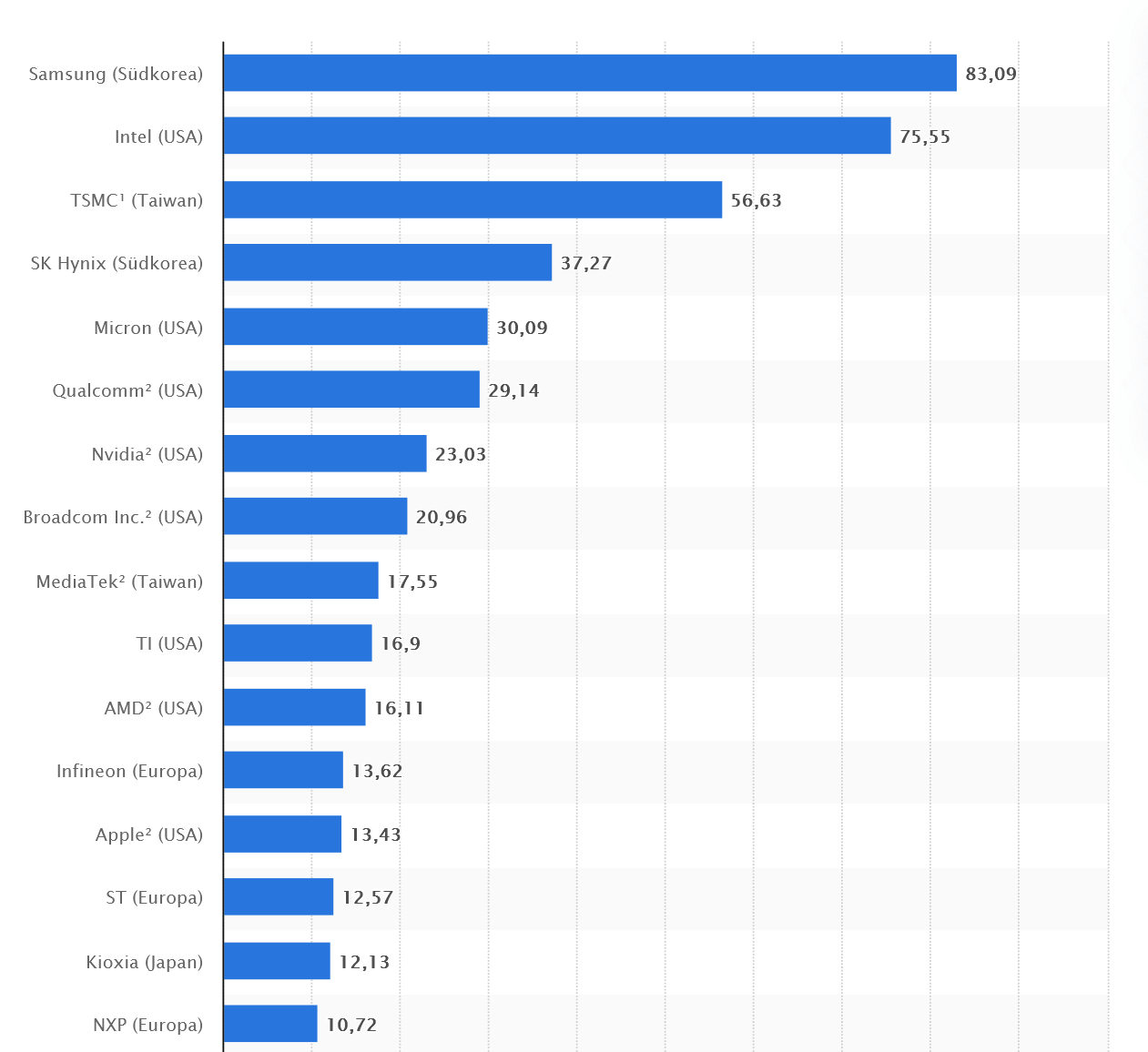Thousands of Chip Factories in China are shutting down
According to a report by DigiTimes, about 10,000 Chinese companies specializing in chip development have shut down operations between 2021 and 2022.
As part of the “Made in China 2025” strategy, the Chinese government has made increased efforts to strengthen the domestic semiconductor industry. This has led to a wave of start-ups in recent years, creating thousands of new companies in the chip industry. However, this strategy didn’t really work for various reasons, which is why most of their plants have now closed again.

Thousands of Chip Factories in China are shutting down
According to a report by DigiTimes, about 10,000 Chinese companies specializing in chip development have shut down operations between 2021 and 2022.
As part of the “Made in China 2025” strategy, the Chinese government has made increased efforts to strengthen the domestic semiconductor industry. This has led to a wave of start-ups in recent years, creating thousands of new companies in the chip industry. However, this strategy didn’t really work for various reasons, which is why most of their plants have now closed again.

China’s dependence on imported chips remains
China’s dependence on imported chips remains
In 2014, China launched the US$22 billion National Integrated Circuit Industry Investment Fund, also known as the “Big Fund“, as part of the “Made in China 2025” strategy to reduce its dependence on imported chips to reduce. So far, however, there has been no success. Currently, only 16 percent of semiconductors in China are locally produced, and these are among the least demanding in each category. Last year, China announced a second “big fund” to invest another $29 billion in semiconductor development. Despite these efforts, China still imports about 90 percent of the chips it needs.
The closure of the chip manufacturers has very different reasons. For example, there has been significant abuse of subsidies and corruption in the past. In addition, the “human factor” plays a crucial role: many new Chinese companies did not have the necessary management know-how to design or manufacture competitive chips. In addition, there is a lack of sufficiently qualified specialists in China who can work in this high-tech field. The largest chip manufacturer in the world remains the undisputed Samsung based in South Korea.
China’s zero-Covid policy has also contributed to the bankruptcy wave, as it led to a collapse in production and consumption in many developed countries around the world last year, severely affecting demand for domestic chips. In addition, US sanctions prevent the import of urgently needed technology and know-how to China.
The most advanced Chinese chip company is Semiconductor Manufacturing International Corporation (SMIC), based in Shanghai. Similar to Huawei, SMIC is on US Departments of Commerce and Defense watch lists, severely limiting its access to US technology and funding. Without foreign support, SMIC is still a long way from making a chip like the Kirin 9000 for smartphones, for example.
Wie Albert Einstein schon sehr treffend sagte: “Die Definition von Wahnsinn ist, immer das Gleiche zu tun und andere Ergebnisse zu erwarten”
The Kirin 9000, like other leading CPUs, was designed for silicon wafers that are five nanometers in size. In the case of semiconductors, the smaller the better. Currently, SMIC can only produce 14 nanometer chips. Although plans have been announced for making seven nanometer chips, they lack the appropriate machinery and tooling to make those plans a reality.
In an interview with Discourse, George Calhoun, a professor at the Stevens Institute of Technology in New Jersey, describes the “Beijing art of failure“: It is a top-down, Soviet-style program in which a lot of money is invested and Subsidies are provided for all. This has already been tried several times. In the latest round, Beijing rolled out a new set of incentives for semiconductor companies.
As Albert Einstein once said, “The definition of insanity is doing the same thing over and over and expecting different results.”
In 2014, China launched the US$22 billion National Integrated Circuit Industry Investment Fund, also known as the “Big Fund“, as part of the “Made in China 2025” strategy to reduce its dependence on imported chips to reduce. So far, however, there has been no success. Currently, only 16 percent of semiconductors in China are locally produced, and these are among the least demanding in each category. Last year, China announced a second “big fund” to invest another $29 billion in semiconductor development. Despite these efforts, China still imports about 90 percent of the chips it needs.
The closure of the chip manufacturers has very different reasons. For example, there has been significant abuse of subsidies and corruption in the past. In addition, the “human factor” plays a crucial role: many new Chinese companies did not have the necessary management know-how to design or manufacture competitive chips. In addition, there is a lack of sufficiently qualified specialists in China who can work in this high-tech field. The largest chip manufacturer in the world remains the undisputed Samsung based in South Korea.
China’s zero-Covid policy has also contributed to the bankruptcy wave, as it led to a collapse in production and consumption in many developed countries around the world last year, severely affecting demand for domestic chips. In addition, US sanctions prevent the import of urgently needed technology and know-how to China.
The most advanced Chinese chip company is Semiconductor Manufacturing International Corporation (SMIC), based in Shanghai. Similar to Huawei, SMIC is on US Departments of Commerce and Defense watch lists, severely limiting its access to US technology and funding. Without foreign support, SMIC is still a long way from making a chip like the Kirin 9000 for smartphones, for example.
Wie Albert Einstein schon sehr treffend sagte: “Die Definition von Wahnsinn ist, immer das Gleiche zu tun und andere Ergebnisse zu erwarten”
The Kirin 9000, like other leading CPUs, was designed for silicon wafers that are five nanometers in size. In the case of semiconductors, the smaller the better. Currently, SMIC can only produce 14 nanometer chips. Although plans have been announced for making seven nanometer chips, they lack the appropriate machinery and tooling to make those plans a reality.
In an interview with Discourse, George Calhoun, a professor at the Stevens Institute of Technology in New Jersey, describes the “Beijing art of failure“: It is a top-down, Soviet-style program in which a lot of money is invested and Subsidies are provided for all. This has already been tried several times. In the latest round, Beijing rolled out a new set of incentives for semiconductor companies.
As Albert Einstein once said, “The definition of insanity is doing the same thing over and over and expecting different results.”
Popular Posts:
AI in everyday office life: Your new invisible colleague
AI won't replace you – but those who use it will have a competitive edge. Make AI your co-pilot in the office! We'll show you four concrete hacks for faster emails, better meeting notes, and solved Excel problems. Get started today, no IT degree required.
Fünf vor Zwölf: Wie Sie erkennen, dass Sie kurz vor dem Burnout stehen
Erschöpfung ist normal, doch wenn das Wochenende keine Erholung mehr bringt und Zynismus die Motivation ersetzt, stehen Sie kurz vor dem Burnout. Erfahren Sie, welche 7 Warnsignale Sie niemals ignorieren dürfen und warum es jetzt lebenswichtig ist, die Notbremse zu ziehen
Die Renaissance des Büros: Warum Präsenz manchmal unschlagbar ist
Homeoffice bietet Fokus, doch das Büro bleibt als sozialer Anker unverzichtbar. Spontane Innovation, direktes Voneinander-Lernen und echtes Wir-Gefühl sind digital kaum zu ersetzen. Lesen Sie, warum Präsenz oft besser ist und wie die ideale Mischung für moderne Teams aussieht.
New Work & Moderne Karriere: Warum die Karriereleiter ausgedient hat
Die klassische Karriereleiter hat ausgedient. New Work fordert ein neues Denken: Skills statt Titel, Netzwerk statt Hierarchie. Erfahre, warum das "Karriere-Klettergerüst" deine neue Realität ist und wie du dich mit 4 konkreten Schritten zukunftssicher aufstellst.
Die Homeoffice-Falle: Warum unsichtbare Arbeit deine Beförderung gefährdet
Produktiv im Homeoffice, doch befördert wird der Kollege im Büro? Willkommen in der Homeoffice-Falle. "Proximity Bias" lässt deine Leistung oft unsichtbar werden. Lerne 4 Strategien, wie du auch remote sichtbar bleibst und deine Karriere sicherst – ganz ohne Wichtigtuerei.
Microsoft Loop in Teams: The revolution of your notes?
What exactly are these Loop components in Microsoft Teams? We'll show you how these "living mini-documents" can accelerate your teamwork. From dynamic agendas to shared, real-time checklists – discover practical use cases for your everyday work.
Popular Posts:
AI in everyday office life: Your new invisible colleague
AI won't replace you – but those who use it will have a competitive edge. Make AI your co-pilot in the office! We'll show you four concrete hacks for faster emails, better meeting notes, and solved Excel problems. Get started today, no IT degree required.
Fünf vor Zwölf: Wie Sie erkennen, dass Sie kurz vor dem Burnout stehen
Erschöpfung ist normal, doch wenn das Wochenende keine Erholung mehr bringt und Zynismus die Motivation ersetzt, stehen Sie kurz vor dem Burnout. Erfahren Sie, welche 7 Warnsignale Sie niemals ignorieren dürfen und warum es jetzt lebenswichtig ist, die Notbremse zu ziehen
Die Renaissance des Büros: Warum Präsenz manchmal unschlagbar ist
Homeoffice bietet Fokus, doch das Büro bleibt als sozialer Anker unverzichtbar. Spontane Innovation, direktes Voneinander-Lernen und echtes Wir-Gefühl sind digital kaum zu ersetzen. Lesen Sie, warum Präsenz oft besser ist und wie die ideale Mischung für moderne Teams aussieht.
New Work & Moderne Karriere: Warum die Karriereleiter ausgedient hat
Die klassische Karriereleiter hat ausgedient. New Work fordert ein neues Denken: Skills statt Titel, Netzwerk statt Hierarchie. Erfahre, warum das "Karriere-Klettergerüst" deine neue Realität ist und wie du dich mit 4 konkreten Schritten zukunftssicher aufstellst.
Die Homeoffice-Falle: Warum unsichtbare Arbeit deine Beförderung gefährdet
Produktiv im Homeoffice, doch befördert wird der Kollege im Büro? Willkommen in der Homeoffice-Falle. "Proximity Bias" lässt deine Leistung oft unsichtbar werden. Lerne 4 Strategien, wie du auch remote sichtbar bleibst und deine Karriere sicherst – ganz ohne Wichtigtuerei.
Microsoft Loop in Teams: The revolution of your notes?
What exactly are these Loop components in Microsoft Teams? We'll show you how these "living mini-documents" can accelerate your teamwork. From dynamic agendas to shared, real-time checklists – discover practical use cases for your everyday work.


































